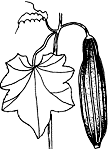View crop
View crop Data sheet EcoPortLuffa acutangula
 |
|
| Notes |
|---|
| BRIEF DESCRIPTION A climbing annual herb with simple, palmately lobed leaves. The fruit is a dry and fibrous capsule with a dry fibrous skeleton inside that is a spongy network. USES The fruits are eaten as vegetables. The fruits usually cooked or fried and are used in chop suey. Shoots, flower buds, flowers, and young leaves are cooked and eaten as greens. Young fruits of sweet cultivars may be eaten raw like cucumbers and small fruits can be pickled. The fruits and leaves also have medicinal properties. The seeds yield an edible oil. GROWING PERIOD Annual. First immature, tender fruits may be harvested 40-70 days from sowing or planting. Fully mature fruits are bitter and inedible. COMMON NAMES Angled loofah, Angled luffa, Ridged gourd, Silk gourd, Ridged gourd, Angled gourd Courge torchon, Jhinga-torooee, Hireballi, Papangay, Peerkankai, Veta kola, Dara veta-cola, Ketola sagi, Vegetable gourd, Chinese okra, Patolang Tag-alog, Sze kwa, Singkwa towelgourd, Seequa, Dishcloth gourd, Oyong, Gambas, Petola, Ketola, Petola sagi, Patola, Kabatiti, Buyo-buyo, Ronoong chrung, Looy, Buap, Buap-liam, Manoi-liam. FURTHER INF Scientific synonym: Cucumis acutangula. Angled loofah probably originated in India where wild forms still occur. It is well adapted for the growing conditions in the tropical lowlands at elevations less than 500 m. Excessive rain may reduce flowering and fruiting. In seasonal climates dry-season planting is more successful than wet-season planting. About 15-20 fruits may be produced per plant. Mentioned as a useful agroforestry species. Photosynthesis pathway C3. | Sources |
| SOURCES (L. acutangula (L.) Roxb.) Tindall H 1983 pp 173-176 [RAIN, FER, TEXT, TEMP] Duke J 1975 pp 20 [PH, RAIN, TEMP] Rice R 1990 pp 255-256 [TEMP, FER, PH, FER] Purseglove J 1974 pp 128 [USE, TEMP] Roecklein J 1987 pp 196 [USE] Huei-mei Li 1995 (pers. comm.) Siemonsma J 1993 pp 194-197 [USE, KTMP, RAIN, PHO, FER, DRA, PH, TEXT] |